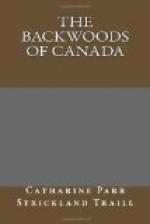With the exception of Quebec and Montreal, I must give the preference to the Upper Province. If not on so grand a scale, the scenery is more calculated to please, from the appearance of industry and fertility it displays. I am delighted, in travelling along the road, with the neatness, cleanliness, and comfort of the cottages and farms. The log-house and shanty rarely occur, having been supplanted by pretty frame houses, built in a superior style, and often painted white-lead colour or a pale pea-green. Around these habitations were orchards, bending down with a rich harvest of apples, plums, and the American crab, those beautiful little scarlet apples so often met with as a wet preserve among our sweetmeats at home.
You see none of the signs of poverty or its attendant miseries. No ragged, dirty, squalid children, dabbling in mud or dust; but many a tidy, smart-looking lass was spinning at the cottage-doors, with bright eyes and braided locks, while the younger girls were seated on the green turf or on the threshold, knitting and singing as blithe as birds.
There is something very picturesque in the great spinning-wheels that are used in this country for spinning the wool, and if attitude were to be studied among our Canadian lasses, there cannot be one more becoming, or calculated to show off the natural advantages of a fine figure, than spinning at the big wheel. The spinster does not sit, but walks to and fro, guiding the yarn with one hand while with the other she turns the wheel.
I often noticed, as we passed by the cottage farms, hanks of yarn of different colours hanging on the garden or orchard fence to dry; there were all manner of colours, green, blue, purple, brown, red, and white. A civil landlady, at whose tavern we stopped to change horses, told me these hanks of yarn were first spun and then dyed by the good wives, preparatory to being sent to the loom. She showed me some of this home-spun cloth, which really looked very well. It was a dullish dark brown, the wool being the produce of a breed of black sheep. This cloth is made up in different ways for family use.
“Every little dwelling you see,” said she, “has its lot of land, and, consequently, its flock of sheep; and, as the children are early taught to spin, and knit, and help dye the yarn, their parents can afford to see them well and comfortably clothed.
“Many of these very farms you now see in so thriving a condition were wild land thirty years ago, nothing but Indian hunting-grounds. The industry of men, and many of them poor men, that had not a rood of land of their own in their own country, has effected this change.”
I was much gratified by the reflection to which this good woman’s information gave rise. “We also are going to purchase wild land, and why may not we see our farm, in process of time,” thought I, “equal these fertile spots. Surely this is a blessed country to which we have emigrated,” said I, pursuing the pleasing idea, “where every cottage abounds with the comforts and necessaries of life.”




